I hope I picked the correct thread for posting. This is my first post and now a registered member of this wonderful community. I have learned so much from so many posts and discussion on this website. I am hoping someone may be able to help me with this issue.
My Vrolik's Wrasse (Halichoeres chrystaenia) has a large distention below his pectoral fin. It could have started to develop as long as two days ago; I left for work early yesterday before the tank lights were on. He is only out in the morning through mid afternoon so I don't see in the evenings, and it burrows in the sand the rest of the day/night. He was swimming and eating as normal (attacking the clam as it fell to the bottom of the tank) today when I saw him. I say him, but I truly do not know the sex. He was added to the tank 1/29/2022 and the most recent fish that were added were (2) blue/green chromis and a valentini saddle puffer that came from a tank I dismantled on 12/19/2023. Current tank mates are (1) neon cleaner wrasse, (2) clown fish, (2) blue/green chromies, (1) royal gramma, (1) radial filefish, (1) diamond watchman goby, (1) valentine saddle puffer, and (1) juvenile powder blue tang. Tank Details: 75g, temperature 74.9 F, SG 1.025, alkalinity 11 dKH, phosphate 0.05 mg/L, nitrate 1.2 mg/L, nitrite 50 ug/L, ammonia non detect, and pH 8.1, last 20% water change was 17 days ago, and I use a Fluval 407. The Fluval canister and pre-filter sponges are cleaned with each water change and replaced every 3 months (sooner if needed). In the filter aside from the sponges are: Seachem Matrix, Seachem Purigen, and Seachem Phosgaurd. The Fish are fed a minimum of three times a day, but this fish typically only eats in the morning. Morning feeding: table seafood clam, scallop, or shrimp, and a rotating mix of frozen: Reef Frenzy, brine shrimp, fish eggs, sponge, Mysis shrimp, mussel, spirulina, plankton, blood worms, and a sheet of nori every 2-3 days; 3:00pm: hikari pellets and ocean nutrition flakes; 7pm: a rotating mix of frozen: Reef Frenzy, brine shrimp, fish eggs, sponge, Mysis shrimp, mussel, spirulina, plankton, blood worms. The frozen food is fed in small amounts so all can be consumed within ~5 minutes. I hope I have provided enough information.



My Vrolik's Wrasse (Halichoeres chrystaenia) has a large distention below his pectoral fin. It could have started to develop as long as two days ago; I left for work early yesterday before the tank lights were on. He is only out in the morning through mid afternoon so I don't see in the evenings, and it burrows in the sand the rest of the day/night. He was swimming and eating as normal (attacking the clam as it fell to the bottom of the tank) today when I saw him. I say him, but I truly do not know the sex. He was added to the tank 1/29/2022 and the most recent fish that were added were (2) blue/green chromis and a valentini saddle puffer that came from a tank I dismantled on 12/19/2023. Current tank mates are (1) neon cleaner wrasse, (2) clown fish, (2) blue/green chromies, (1) royal gramma, (1) radial filefish, (1) diamond watchman goby, (1) valentine saddle puffer, and (1) juvenile powder blue tang. Tank Details: 75g, temperature 74.9 F, SG 1.025, alkalinity 11 dKH, phosphate 0.05 mg/L, nitrate 1.2 mg/L, nitrite 50 ug/L, ammonia non detect, and pH 8.1, last 20% water change was 17 days ago, and I use a Fluval 407. The Fluval canister and pre-filter sponges are cleaned with each water change and replaced every 3 months (sooner if needed). In the filter aside from the sponges are: Seachem Matrix, Seachem Purigen, and Seachem Phosgaurd. The Fish are fed a minimum of three times a day, but this fish typically only eats in the morning. Morning feeding: table seafood clam, scallop, or shrimp, and a rotating mix of frozen: Reef Frenzy, brine shrimp, fish eggs, sponge, Mysis shrimp, mussel, spirulina, plankton, blood worms, and a sheet of nori every 2-3 days; 3:00pm: hikari pellets and ocean nutrition flakes; 7pm: a rotating mix of frozen: Reef Frenzy, brine shrimp, fish eggs, sponge, Mysis shrimp, mussel, spirulina, plankton, blood worms. The frozen food is fed in small amounts so all can be consumed within ~5 minutes. I hope I have provided enough information.


















